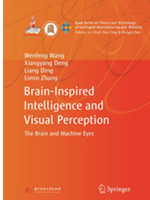您现在的位置:e-works
> 智造书屋 >
书籍列表 > Brain-inspired Intelligenceand Visual Perception:The Brain and Machine Eyes(类脑智能与视觉感知)
Brain-inspired Intelligenceand Visual Perception:The Brain and Machine Eyes(类脑智能与视觉感知)
查看您的阅读历史
- 类别:
- 先进制造技术
- | 关键字:
- 视觉感知
- 本书主要介绍关于大脑启发的智力和视觉感知(BIVP)研究的最新成果。我们收集BIVP的新的研究假设,包括介绍脑科学和视觉脑假说。此外,本文还介绍了BIVP的理论和算法,包括信息素积累与迭代、神经认知计算机制、核心模块的集成与调度、大脑感知、运动与控制。这本书不仅包含基本概念、理论和规律,以前分散在许多有影响的期刊和会议上,而且包含作者的项目中的一系列最新研究进展,包括中国科学院的“西部之光”计划(XBBS-2014-16),国家自然科学院中国科学基金会(41571299)、中国“千人计划”(Y47161)、国家基础研究计划(2013CB035502)和国家高技术研究发展计划(2013AA122302)。本书即可以供大学研究人员、研发工程师、本科生和研究生学习以及对机器人、脑认知或计算机视觉感兴趣的读者参考。
1Introduction of Brain Cognition
- 第一节 Background
- 第二节 Theory and Mechanisms
- 第三节 From Detection to Tracking
- 第四节 Objectives and Contributions
- 第五节 Outline of the Book
2The Vision-Brain Hypothesis
- 第一节 Background
- 第二节 Attention Mechanisms
- 第三节 Locally Compressive Cognition
- 第四节 An Example of the Vision-Brain
3Pheromone Accumulation and Iteration
- 第一节 Background
- 第二节 Improving the Classical Ant Colony Optimization
- 第三节 Experiment Tests of the SPB-ACO
- 第四节 ACO Algorithm with Pheromone Marks
- 第五节 Two Coefficients of Ant Colony's Evolutionary Phases
- 第六节 Experimental Tests of PM-ACO
- 第七节 Further Applications of the Vision-Brain Hypothesis
4Neural Cognitive Computing Mechanisms
- 第一节 Background
- 第二节 The Full State Constrained Wheeled Mobile Robotic System
- 第三节 The Controller Design and Theoretical Analyses
- 第四节 Validation of the Nonlinear WMR System
- 第五节 System Improvement by Reinforced Learning
- 第六节 Stability Analysis of the Enhanced WMR System
5Integration and Scheduling of Core Modules
- 第一节 Background
- 第二节 Theoretical Analyses
- 第三节 Simulation and Discussion





